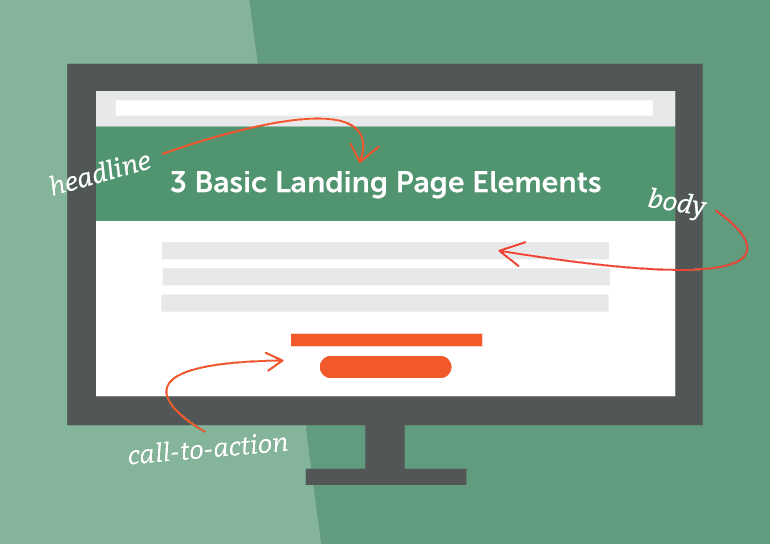How To Write Landing Pages That Will Boost Your Conversions
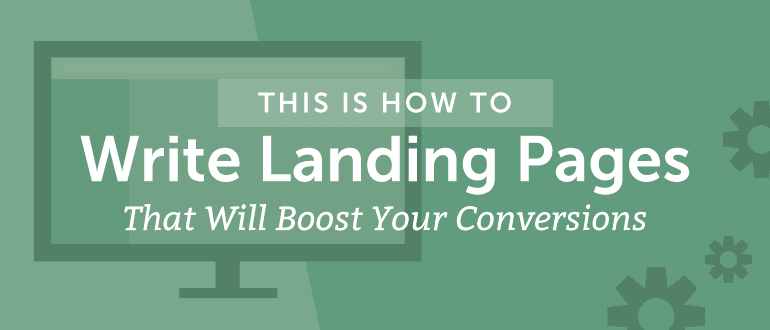 Writing landing pages is an art.
Successful landing pages address a need, provide a solution, and (ideally) drive conversions.
The challenge lies in getting your audience to convert or perform an action (sign up for a contest, subscribe to an email list, etc).
Fortunately, anyone with writing skills can learn to write effective landing pages.
That’s exactly what this post will teach you to do.
Try CoSchedule's Landing Page Generator to instantly get ideas for your landing page!
Writing landing pages is an art.
Successful landing pages address a need, provide a solution, and (ideally) drive conversions.
The challenge lies in getting your audience to convert or perform an action (sign up for a contest, subscribe to an email list, etc).
Fortunately, anyone with writing skills can learn to write effective landing pages.
That’s exactly what this post will teach you to do.
Try CoSchedule's Landing Page Generator to instantly get ideas for your landing page!
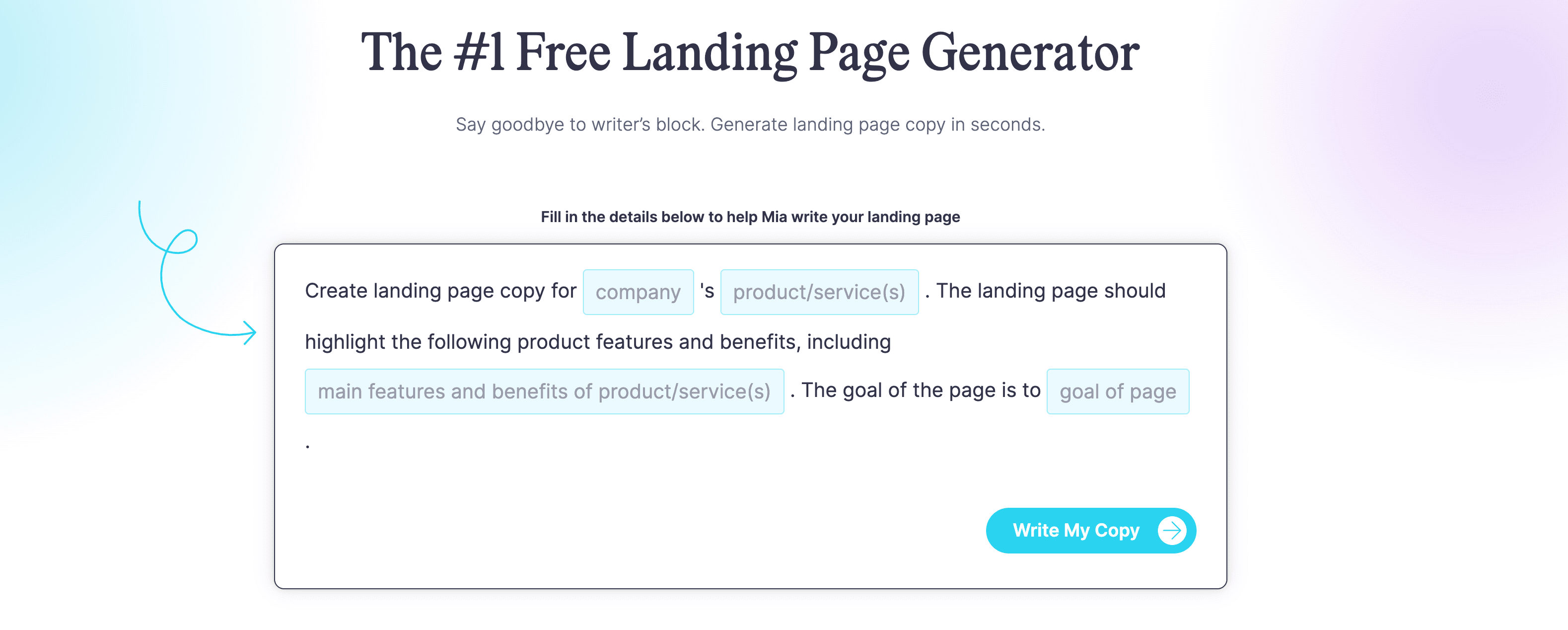 Source
Source
Download Your Free Landing Page Resources
Write better landing pages and track your performance with these three free resources:- Landing Page Writing Template
- Landing Page Performance Tracking Template
- Call To Action Guide
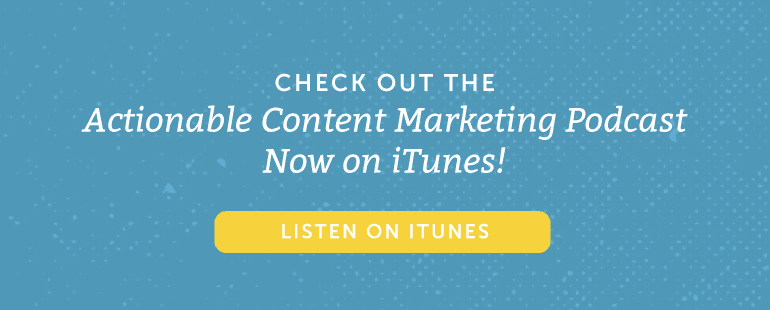
Why Should You Be Writing Landing Pages?
The purpose of any landing pages is to get your reader to perform a specific action. You may want your reader to complete an email sign-up form, register for an event, or start a trial for a service (just for a few examples). Whatever you consider to be your conversion step, everything write you should support that goal. This should be the central focus of your writing.What Defines A Landing Page?
By definition, a landing page is any page a user could "land on" from another page. According to Unbounce,In the purest sense, a landing page is any web page that a visitor can arrive at or “land” on. However, when discussing landing pages within the realm of marketing and advertising, it’s more common to refer to a landing page as being a standalone web page distinct from your main website that has been designed for a single focused objective. This means that your landing page should have no global navigation to tie it to your primary website. The main reason for this is to limit the options available to your visitors, helping to guide them toward your intended conversion goal.For our purposes, any solid landing page should have the following:
- A strong headline
- Body copy
- A call-to-action
What Are Some Common Purposes For Landing Pages?
Any landing page should serve one clear defined purpose. Here are some common usages for standalone landing pages:- Promote an event or webinar
- Gather email newsletter signups
- Promote a free trial
- Offer free coupon signup
- Drive signups to be alerted of a new product or feature launch
- Host a contest signup form
How To Define A Purpose For Your Landing Page
The first step is to decide what your landing page will be about. If you're promoting something specific, like an event or contest, then your topic is obvious. In other cases, you may need to get more creative. If you're struggling to define a clear purpose for your page, try following some of these tips.Landing pages should have just one clear purpose.
Click To TweetIdentify A Problem You Can Solve For Your Audience
A great way to find a topic is to identify an issue and present your product or service as the best solution. The reason your audience is on your landing page is because they have a problem and need a solution, and that’s you! Here are some quick ways to determine what your audience could use help with:- Twitter polls. Twitter's help guide can help walk you through how to set one up.
- Audience surveys. Tools like Polldaddy and Survey Monkey make it easy to run surveys.
- Quick questions posted on social media. Tweet a question for your audience asking what challenges they're facing. Then, create a page that presents a solution.
Identify A Problem Your Business Needs To Solve
Another approach is to start with a problem your business is facing. Unbounce did a great case study on New Balance. The shoe company's brick-and-mortar stores in Chicago weren't getting enough foot traffic, and they wanted to increase sales. So, they ran Facebook ads that directed to landing pages promoting sales on shoes. This approach increased sales by 200%. This is a perfect example of identifying a business problem, and solving it with effective landing page messaging.Next, Find Your Keyword
If you plan on using SEO or PPC to drive landing page traffic, then it's important to properly select keywords. Selecting a keyword to target essentially means claiming territory on a certain phrase that is being searched. For example, if you’re trying to sell an ebook on how to master a job interview, you may want to target the phrase “successful job interviews.” There are great tools, both free and paid, that will help you find the traffic around any keyword. Start with these popular options: Choosing a keyword goes back to your angle and topic. The content of your page should also match the search intent behind your selected keyword. You should also target synonyms for your topic and focus.
Do You Need An Angle?
If you're writing a sales brochure-style landing page, consider your angle. Your angle describes the perspective you're writing from. To find your angle here are some questions you can ask yourself before you get writing:- What’s your unique perspective? Showcase your original thoughts and ideas to your reader. Keep them engaged with your business’s individual view on your topic.
- What makes you different than your competitors? Think in the perspective of your audience. Why would they choose you instead of your competition? Identify what makes your product or service uniquely the best solution.
Catch Your Audience's Attention With An Awesome Headline
A good headline should hook your reader's interest immediately. When it comes to landing pages specifically, it should convey a clear benefit too. Whether the audience finds your landing page through social media, paid advertising, or organic search, you need to give them a reason to care.
Write Persuasive Body Copy
Once readers get past your headline, they'll expect your body copy to deliver. You need to follow through on the promises you made in your headline. Writing good copy isn't easy, but following these steps should help.Start With A Strong Intro Hook
Writing an effective intro is critical for keeping your reader on the page. It can be as simple as a sentence or two, or a full paragraph or more (depending on the legnth and style of your page). Any intro should do one thing, however: show your reader what's in it for them if they keep reading (or even convert). There should be absolutely no confusion as to what the reader will be getting from the landing page. A simple way to ensure that your audience knows what they’ll be getting out of the landing pages is to write clear value propositions. You can end your introduction by stating “you’re going to learn/see/find out how….” and then list 3-5 things that the reader will get out of your landing page. Take a look at one of our own landing page introductions: What if your page isn't text-heavy enough to write this way? Here's another example from WordPress.com that takes a different approach. Here, they have blocks of content, each one stating one clear benefit:
What if your page isn't text-heavy enough to write this way? Here's another example from WordPress.com that takes a different approach. Here, they have blocks of content, each one stating one clear benefit:
 The key is to hook your reader by making benefits immediately clear. Each of these six points solves a different problem, from the difficulty of building a site without knowing code, to getting customer support.
It also shows they clearly know their audience. Someone using WordPress.com probably doesn't have a lot of coding skill. Therefore, all the copy here is focused on ease of use and community support. And it's all conveyed to readers right away.
The key is to hook your reader by making benefits immediately clear. Each of these six points solves a different problem, from the difficulty of building a site without knowing code, to getting customer support.
It also shows they clearly know their audience. Someone using WordPress.com probably doesn't have a lot of coding skill. Therefore, all the copy here is focused on ease of use and community support. And it's all conveyed to readers right away.

Follow The Problem/Solution/Benefit Formula
We've talked a lot about focusing on problems, solutions, and benefits. However, how do you actually write in a way that conveys each of these points? Try following the Problem/Solution/Benefit formula. This isn't the only way to write copy, but it's an easy formula to follow if you're struggling.- Establish a problem. What's a common issue your audience has? Identify it and agitate it.
- Present a solution. Next, state why your product or service as the best solution to their problem. Ensure that your solution covers every detail of their problem.
- Show a benefit. Now, you can show your reader how much better life can be when their problem is solved.
- Problem: Someone has ants in their kitchen.
- Solution: A pest-control company offers non-toxic ant traps.
- Benefit: The customer won't lose any more groceries due to ant infestation.
Write better landing pages by focusing on problems, solutions, and benefits.
Click To TweetMake Your Call-To-Action Count
The next step in creating your landing page is asking yourself, “What do I want readers to do?” The answer to this question should be your call-to-action (CTA). Your CTA is what prompts the reader to convert. For example, if you want your audience to sign up for a contest, your CTA could be “Enter to win this fabulous prize.” Your entire landing page copy would sell the reader on why they should care about you’re promoting enough to enter. Start your writing process by creating your CTA. From there, you can craft your landing page copy in a way that directs the reader to that action.
5 Landing Page Writing Tips
As you plan and write your copy, here are some crucial pointers to remember.Use Clear And Simple Language
Keep sentences short and clear.Focus On Benefits
Your customer knows what their problem is. They probably know what kind of tool or solution they need too. Your job is to show benefits that illustrate why your solution is the best one for a given application. We keep hammering on this point, but that's because it's that important.Remember That Sometimes Less Is More
Landing pages don't have to be long to be effective. Sometimes, all you really need is a headline, simple body copy, and a call-to-action button. Write as much as it takes to make your point and drive your desired action. That's it. Here's an example of a super short landing page from Pedal Train, a company that makes pedal boards for guitar players: A headline, a paragraph of body copy, and a button, all connected to one purpose (getting you to download an infographic). That's all the page needs.
A headline, a paragraph of body copy, and a button, all connected to one purpose (getting you to download an infographic). That's all the page needs.
Analyze Performance (And Do Better Next Time)
Writing high-converting copy often requires experimentation and refinement over time. As you write more landing pages, look for the following:- Which types of headlines perform best?
- What elements do your top-performing CTAs have in common?
- Does short or long copy perform best for you?
Understand The Importance Of Message-Match
If you'll be directing traffic to your landing page with PPC ads or social media ads, then you'll need to make sure your ad messaging matches your landing page messaging. Here's an example. I searched "what is kissmetrics" (an analytics software platform we use). Here's what the ad looked like: And here's the page it directs to:
And here's the page it directs to:
 The headline, both on the ad and the landing page, tells us this is an analytics tool. The landing page intro copy starts by stating benefits (the ability to monitor marketing performance across multiple digital channels). The body content blocks below go into more detail, further illustrating benefits. The call-to-action then gives us the opportunity to try it for ourselves.
That sounds like this hits all the right checkboxes for a successful landing page.
The headline, both on the ad and the landing page, tells us this is an analytics tool. The landing page intro copy starts by stating benefits (the ability to monitor marketing performance across multiple digital channels). The body content blocks below go into more detail, further illustrating benefits. The call-to-action then gives us the opportunity to try it for ourselves.
That sounds like this hits all the right checkboxes for a successful landing page.
Make sure ad messaging matches your landing page messaging.
Click To Tweet3 More Examples Of Awesome Landing Page Copy
What do high-quality landing pages look like in the wild? Let's take a look at some examples.WordStream
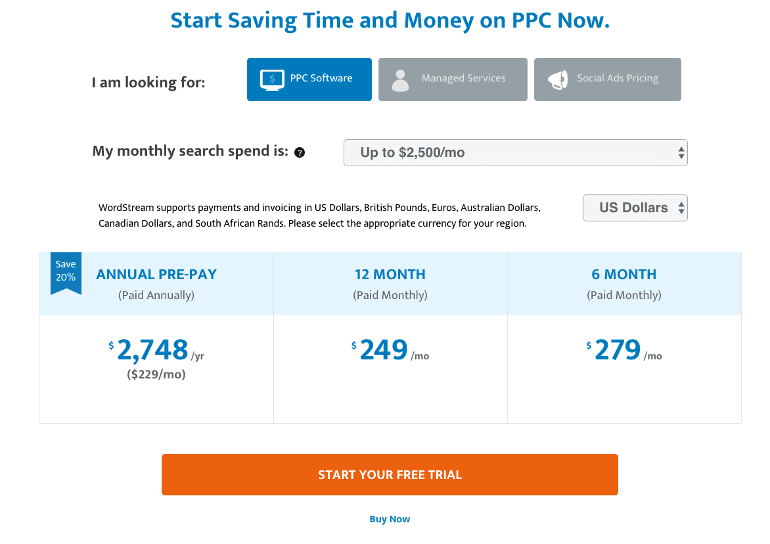 This sign-up page from Wordstream is fairly straightforward. It does quite a few things right though.
This sign-up page from Wordstream is fairly straightforward. It does quite a few things right though.
- The headline conveys a clear benefit (saving time and money).
- The "Start Your Free Trial" call-to-action button is bright, clearly designed, and encourages conversions from customers who might not be ready to buy yet.


Square
This page immediately conveys a benefit to the reader (they can start selling immediately). It then leads into more information they may want to know before making a decision to start a trial. The page continues communicating further benefits, leading readers to more information they might need:
The page continues communicating further benefits, leading readers to more information they might need:
 And then at the end, everything leads to their call-to-action:
And then at the end, everything leads to their call-to-action:

Analyze Your Landing Page Performance
You’ve published your landing page. How do you know how successful they are? You’ll first want to decide on a (reasonable) goal for them.Start By Setting SMART Goals
One great way to set goals is to use the SMART method:- Specific: Clearly define your goal and ensure that it’s not vague. A good example would be “I want to have 2000 conversions this month” instead of “I want more conversions”
- Measureable: Make sure that you can track this goal. Attach a number to it. For example “I want my read time on my landing pages to increase by 30%” should be used instead of “I want people to spend more time on my pages.”
- Aspirational: Don’t sell yourself short. Push yourself.
- Realistic: Make sure you can still attain your goal. Take a good look at your resources and obstacles and ensure that you can manage them to meet your goals.
- Time-bound: Set a time you want to be finished by. Be specific, even down to the hour. Set a goal like “This will be done by 3 p.m on August 2nd” instead of “some point.”
Set landing page goals using the SMART methodology.
Click To TweetMeasure Performance With Analytics Tools
There are a number of analytics platforms you can use. Plus, landing page template services like LeadPages, Unbounce, and Instapage feature built-in analytics. Google Analytics is also a must-use platform (but you probably already knew that). Here are four key metrics to focus on:- Bounce rate. The bounce rate is the percentage of visitors who navigate away from your site after viewing only one page. Typically, marketers are trained to think high bounce rates are bad. However, landing page bounce rates are often high because they give your reader two options: convert, or leave.
- Time on page. Instead of worrying about bounce rates, pay attention to how long people stay on your pages. This is an important metric. The higher the time on your page, the more engaged your readers are. They’re more likely to convert if they’re engaged with what they’re reading on your page. A high time on page is a great metric to measure the quality of the content on your landing page.
- Conversion rate. This is one of the most important metric for landing pages. The conversion rate is the percentage of visitors who convert directly from your page. The success of your landing page will vary differently through every industry, but the higher it is, the better.
- Total conversions. How many form completions is your copy driving? Find out by tracking goals in Google Analytics.
Now Master The Art Of Writing Landing Pages
There’s a definite science to writing successful landing pages. Once you’ve broken the steps down into smaller tasks and set your goals, you can write a landing page that will boost your conversions.This is how to write better landing pages.
Click To Tweet